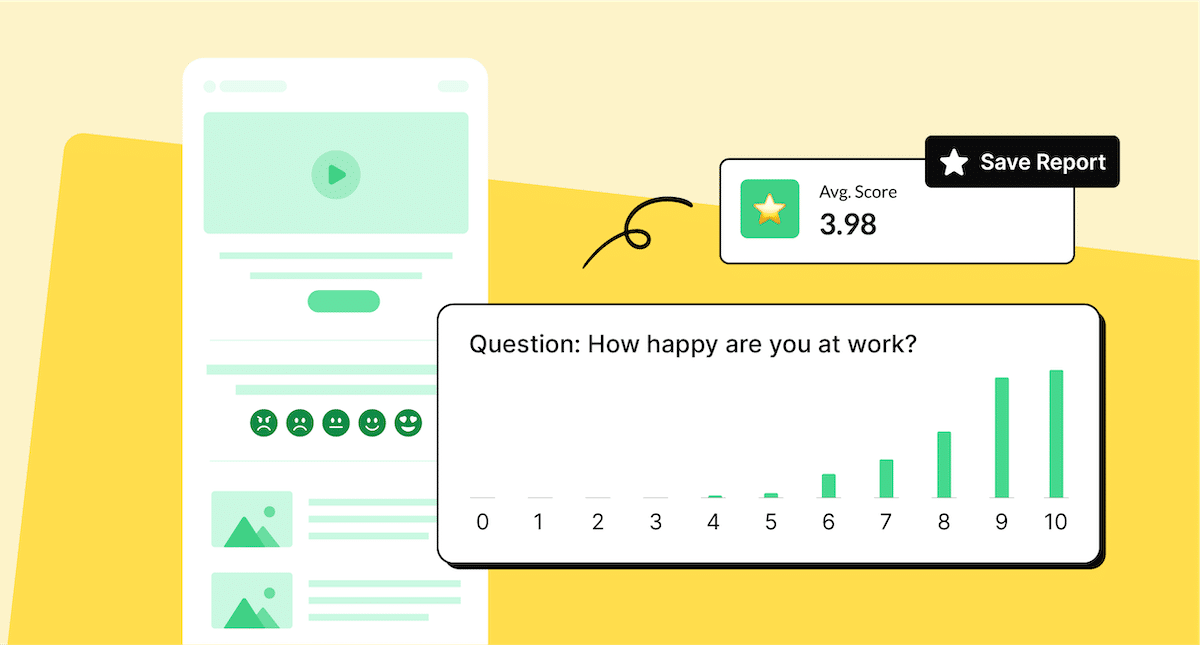Employee surveys help you identify problems and determine solutions to overlooked issues at your business. With ContactMonkey, you can create effective employee survey templates to gather employee feedback faster and easier.
Employee surveys help you understand how your employees feel about particular issues, identify issues that can impact productivity, collect actionable solutions, and assess your overall employee engagement situation.
Employee survey templates are crucial for regularly collecting employee feedback. They help you save time and effort creating employee surveys and maintain consistent branding and messaging when surveying your employees. With ContactMonkey’s employee feedback tool, you can create effective and reusable surveys and track and analyze their results. Learn how ContactMonkey’s employee survey solutions make it quick and easy to create, send, and track your email surveys.
Take a self-guided tour of ContactMonkey
See how our key features can streamline your internal communications.
Take product tour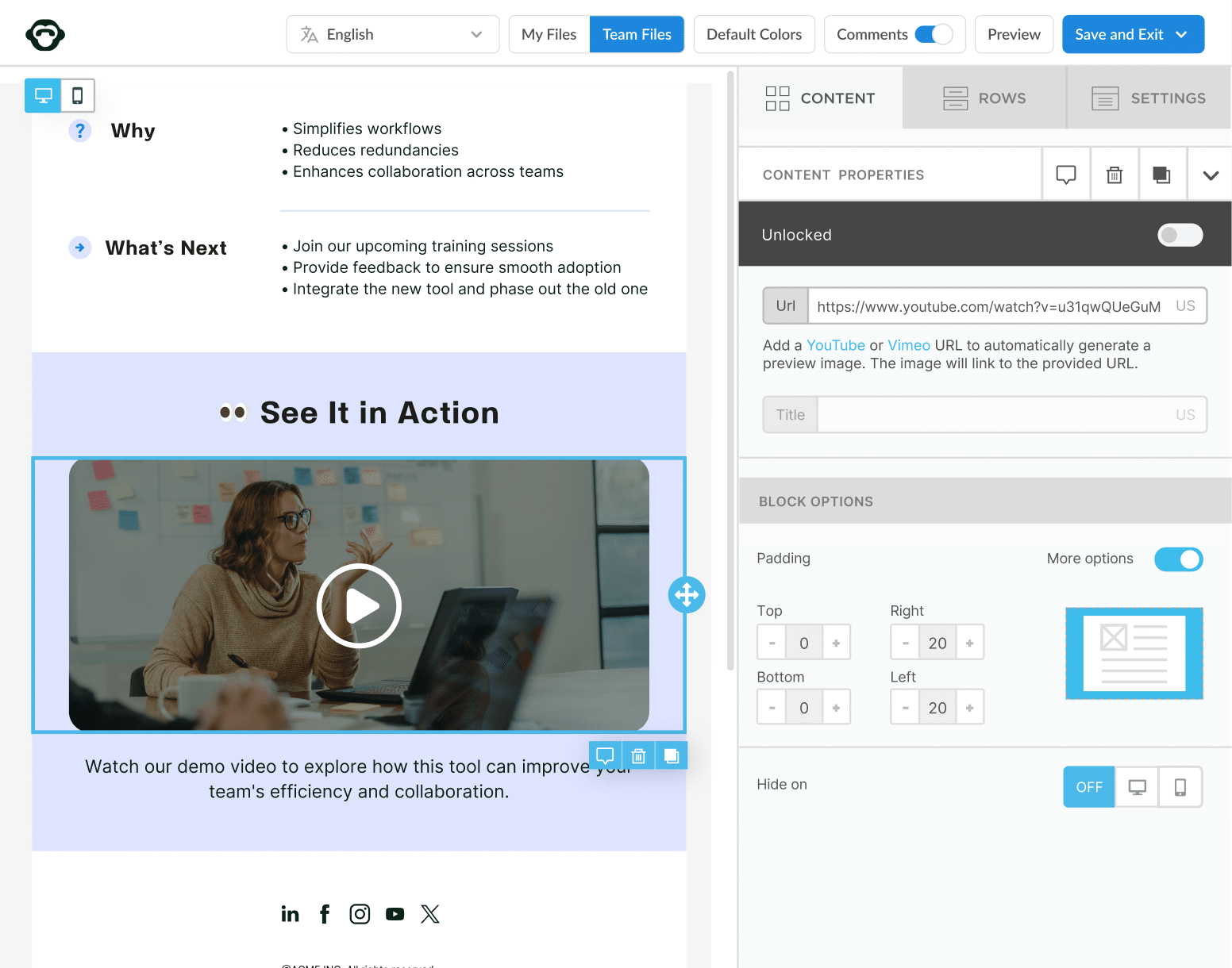
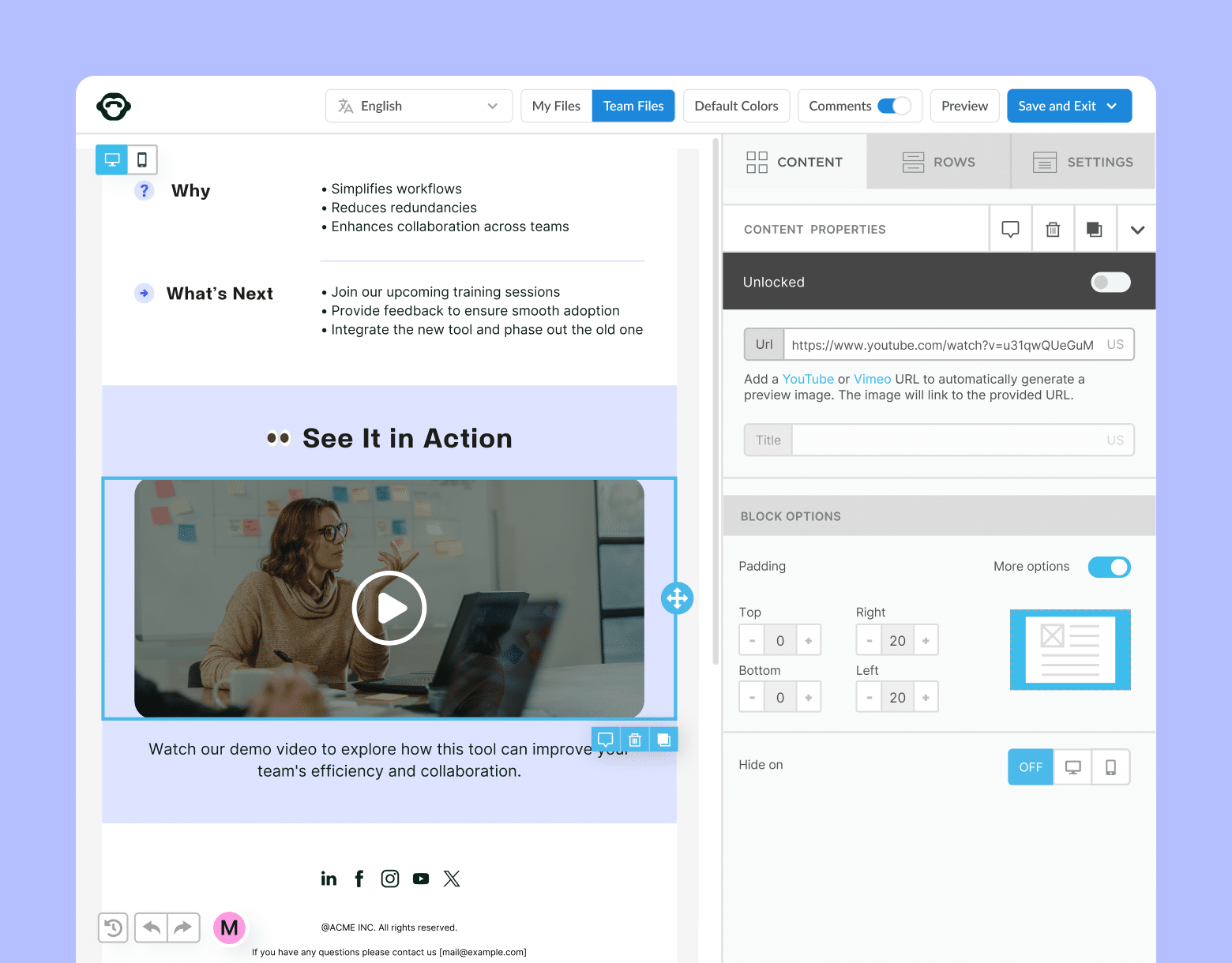
What Are Employee Surveys?
Employee surveys are internal communications where employees can share ideas, voice concerns, and raise issues that affect them and their work. These surveys can vary in length but are always focused on better understanding the values and feelings of your employees.
There are various types of employee surveys focused on different aspects of employee engagement. Qualitative surveys gather more detailed employee insights. They include staff spotlight questions and anonymous comment surveys. Meanwhile, quantitative surveys include eNPS ratings and yes/no questions.
Employee survey templates are a valuable tool for businesses who conduct regular employee surveys as they save time and effort, and produce feedback that can be used to benchmark engagement over time.
Learn more about the importance of employee surveys and why you should use them at your company.
How often should you conduct an employee survey?
There are two answers to this question:
- It depends on the nature of the survey and the feedback you wish to receive, but
- Not so often that your employees grow tired of providing their feedback
The kind of survey you’re sending dictates how frequently you’ll send it out. Employee pulse surveys are short and require minimal effort for employees, meaning you can send out these surveys more often. Other surveys elicit feedback that will need to be compared with past feedback—like annual employee wellness surveys—meaning they need to be scheduled at annual or quarterly intervals.
If you’re sending multiple surveys to your employees, ensure that you space them out to give your employees some breathing space. Bombarding your employees with surveys can cause them to provide half-hearted feedback, or worse: tune out entirely.
We recommend scheduling your employee surveys ahead of time to avoid congestion. Use our free Internal Communications Planning Calendar to map out your upcoming employee surveys to maximize the quality of the feedback you receive.
Create and send employee surveys for feedback
Engage staff with pulse surveys, eNPS surveys, reusable surveys, custom polls, and more. Ready to send modern emails?
Explore survey features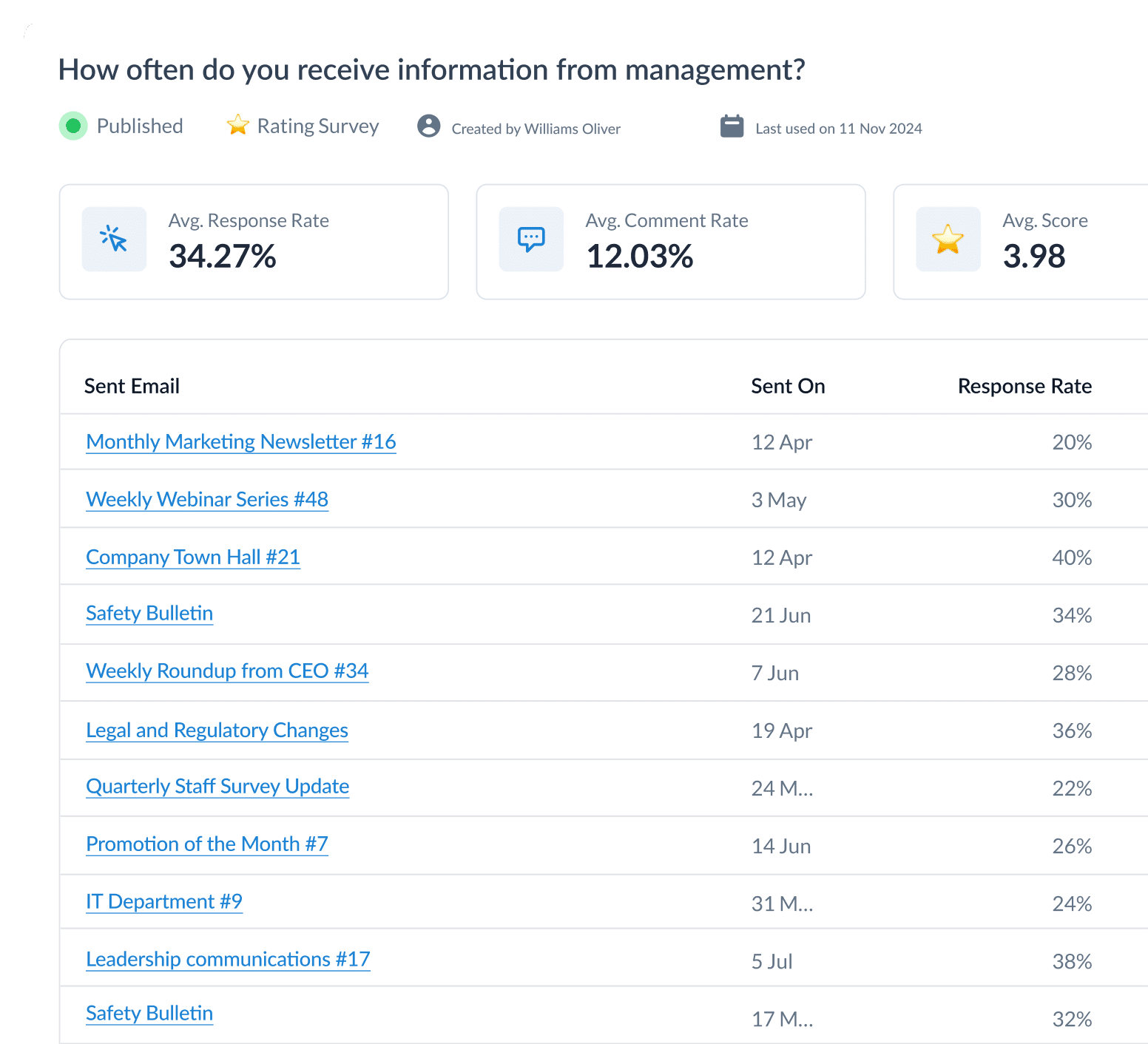
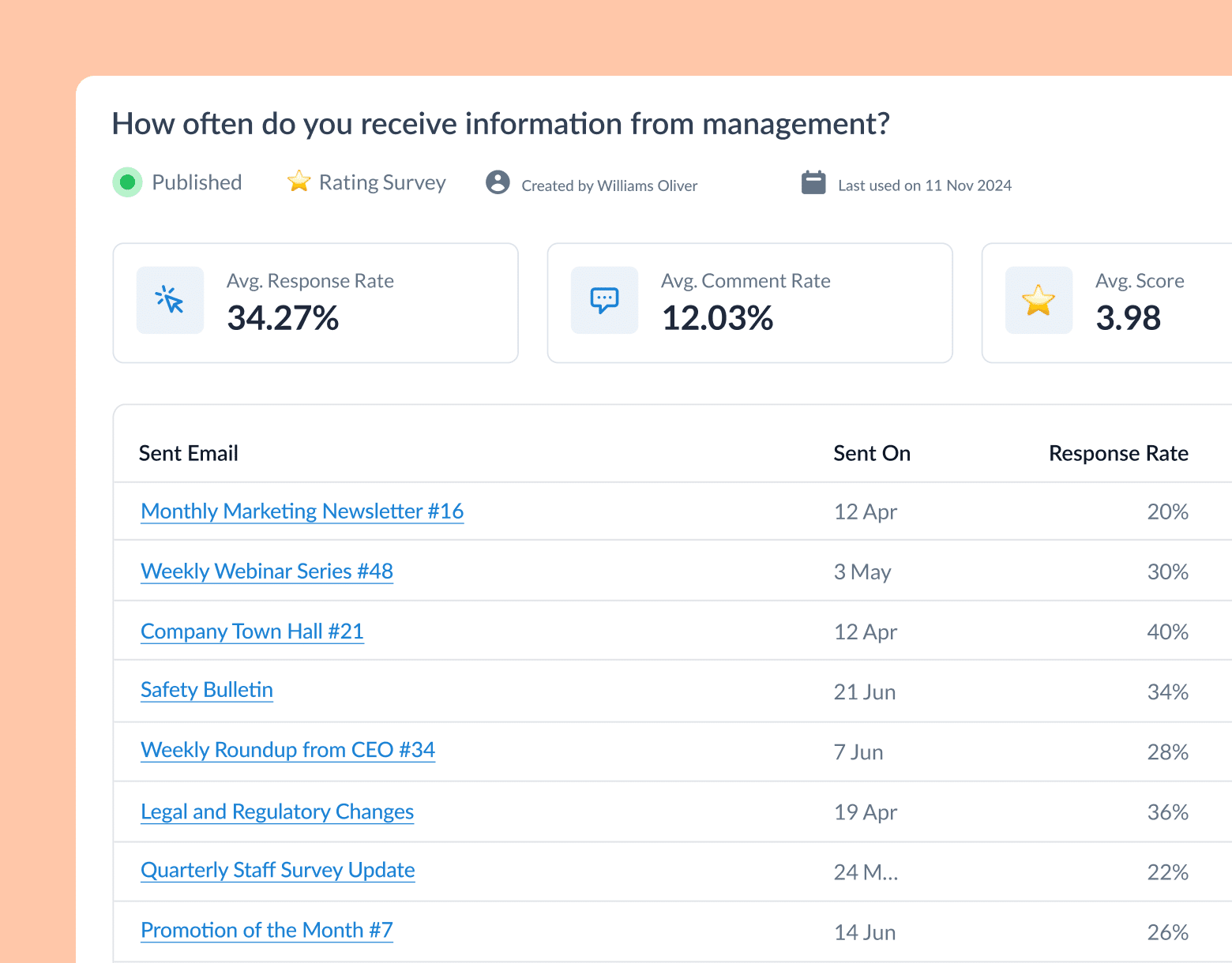
What makes a good employee survey email template?
Again, there are two answers to this question:
- A good employee survey asks questions your employees genuinely care about, and
- Provide you with meaningful, actionable feedback.
Ask concise, pointed questions about issues relevant to your employees, and act on their suggestions when you receive them. If your employees see that you’re taking their feedback seriously, they’ll be more likely to complete your surveys in the future.
Unsure how to gather meaningful employee feedback? Try using ContactMonkey’s OpenAI ChatGPT integration to generate effective survey questions for your employees. Simply write a prompt describing what you’d like to learn, and edit the suggested questions according to your audience.
Benefits of employee survey email templates
Employee survey email templates are the key to incorporating survey into your internal communications strategy. Survey templates have numerous benefits for internal communicators who want to use their internal emails to collect employee feedback:
- Easier survey creation and reduced time to send.
- Quickly reproducible to maintain branding and formatting.
- Access employee responses faster from a centralized employee engagement dashboard.
- Gather email metrics on your surveys to analyze how to increase response rates.
- Mobile capability so your employees can access your email surveys where they are.
- Dark mode compatibility so your surveys display perfectly regardless of their display settings.
Employee survey templates can be created using ContactMonkey’s drag-and-drop email template builder. You can create your own from scratch, choose one from our email template library, or use our Email Design Service to get a reusable, professionally-designed template made by our design team.
You’ll even be able to choose from dozens of pre-made sample internal memos to employees. All you have to do is personalize the copy and your work is done!
Take a self-guided tour of ContactMonkey
See how our key features can streamline your internal communications.
Take product tour

25 Most Popular Employee Email Survey Templates
Email survey templates are innovative employee communications tools that allow you to collect all kinds of employee feedback in an engaging manner. Use our email survey templates to gather feedback that will help you create better internal communications, build employee engagement, and achieve your business goals.
1. Employee benefits survey email template
An employee benefits survey asks employees about their feelings around the benefits they receive from your business. Benefits are a significant incentive for employees to pursue and maintain employment at your company.
Use these surveys as part of your employee benefits communication strategy to gauge satisfaction with your current benefits and get new ideas for what you can offer employees:
Are you aware of the employee benefits program provided by your company?
Are you satisfied with employee benefits provided by your company? If not, please identify areas where we could improve.
How would you rate our employee benefits program compared to other organizations that you have worked for?
2. Employee engagement survey email template
An employee engagement survey helps you measure whether your employees find their work meaningful and fulfilling. Numerous factors contribute to employees finding meaning and fulfillment in their work, which we examine in our employee engagement trends for 2023 article.
Put briefly, employee engagement boils down to three aspects: cognitive engagement, physical engagement, and emotional engagement. A well-made employee engagement survey template should include questions based on these categories.
Consider these three criteria when creating your employee engagement survey email template:
Do our company’s goals align with your own values and priorities? [thumbs up or down]
Do you receive the support you need to succeed at your job? [thumbs up or down]
How does our work environment affect your ability to succeed at your job? [star rating or emoji reactions]
Unlock Internal Comms Superpowers
Discover why 10,000+ rely on us. See the internal email and employee newsletter platform in action.
Book demo

3. Employee motivation survey email template
Employee motivation surveys take the tenets of employee engagement—meaning and fulfillment—one step further by asking employees how likely they are to act based on those feelings. An employee may feel connected to their job, but they might not be motivated to contribute based on that connection for various reasons.
An employee motivation survey helps you find out what may be stopping your employees from contributing more to your company, and can provide useful insights for overcoming these barriers:
I feel like my voice is heard at this company.
I would like to work here as long as possible.
I’m satisfied with the benefits offered.
I receive regular feedback from management.
I am treated with respect by my coworkers and leadership.

4. Employee opinion survey email template
Going beyond employee engagement, surveys like employee opinion surveys give employees the chance to share their thoughts about a wide range of topics. Gather your employees’ opinions about:
- Workload
- Compensation
- Professional development
- Management and leadership
- Company operations and policies
- CEO communication to employees
The length of your opinion surveys will vary based on topic, but we recommend keeping them short and sweet. This way your employees will be able to provide more meaningful feedback about a single topic:
Does your manager recognize your work often?
Do you ever feel that stress from work is affecting your personal life?
Are there any professional development opportunities we are not currently offering that you wish we had?
These kinds of questions are usually best answered beyond a simple yes or no. With ContactMonkey, your employees can share anonymous comments with their survey answers:
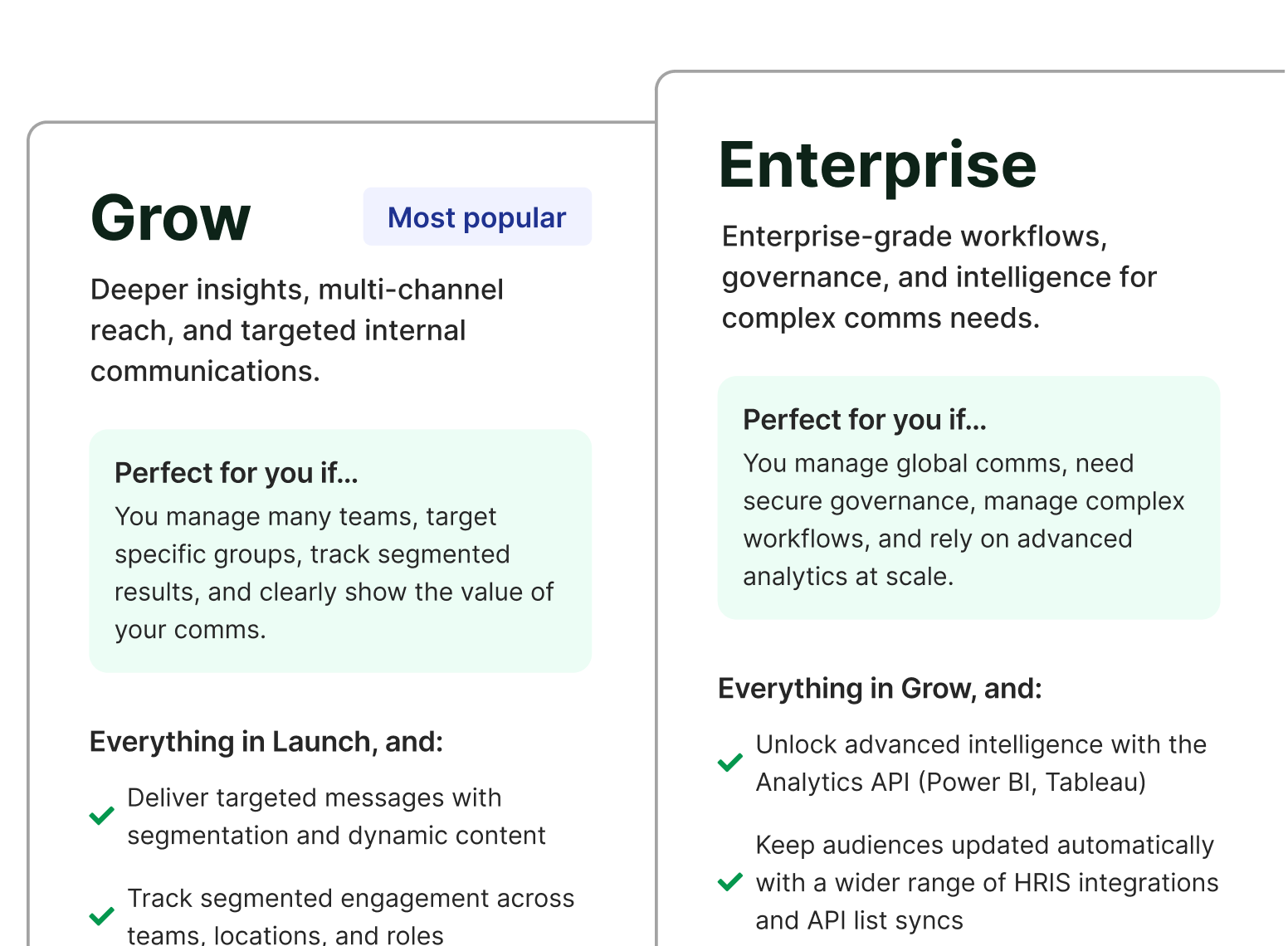
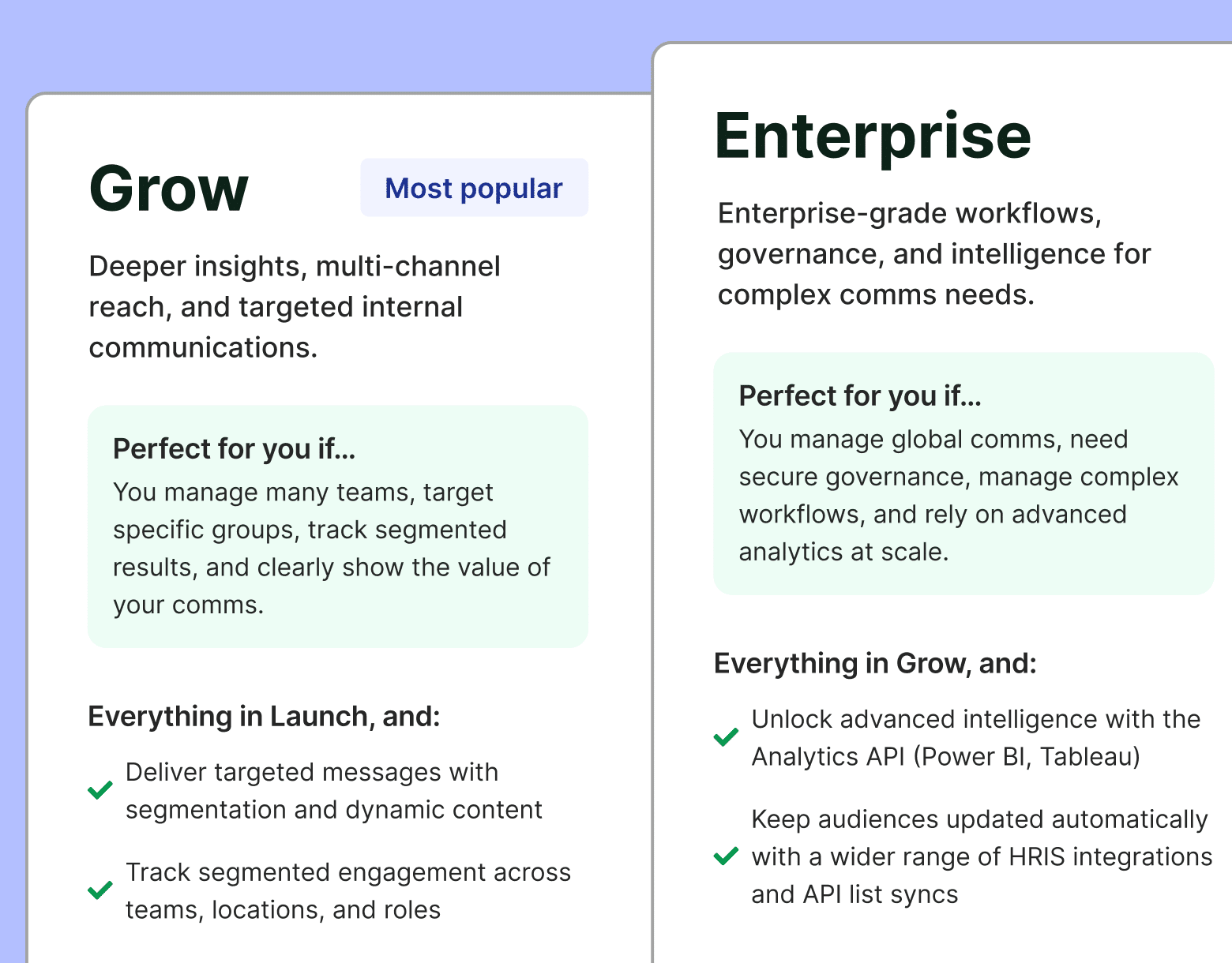
5. Employee pulse survey email template
Pulse surveys are single questions usually included alongside other internal communications content. Like employee opinion surveys, pulse surveys can be used for just about any topic. On your employee pulse survey email template, poll employees about upcoming events, business initiatives, or even about your internal communications:
Did you find this email helpful?
Are you going to attend our upcoming town hall?
Have you checked out our new fitness program? [thumbs up or down]

6. Employee experience survey email template
Employee experience surveys aim to measure the more granular aspects of employee engagement. Where an employee engagement survey deals with an employee’s feelings about their workplace, an employee experience survey examines the specific factors that influence those feelings.
Employee experience can be broken down into three criteria: cultural experience, physical experience, technological experience. Looking at your employee engagement in these ways can help you contextualize the feedback you receive so you can improve employee experience at your business:
Do you agree with your manager’s leadership style? [thumbs up or down]
Does your manager provide you with the resources you need to succeed? [thumbs up or down]
Do you feel comfortable in your workspace? [thumbs up or down]
7. Employee feedback survey email template
An employee feedback survey is the older sibling to the opinion survey. An employee feedback survey email template can get into more detail about a particular topic, and can ask different kinds of questions about it. Since employee feedback survey email templates are generally longer, they should be sent to employees sparingly—like quarterly or yearly.
The topics discussed on employee feedback surveys can vary, but the feedback you receive should ideally be more than a simple yes or no. We recommend collecting anonymous employee comments alongside the default responses for questions like these:
Do you feel that you can ask your manager for feedback openly? [thumbs up or down]
How supported do you feel by your manager? [star rating or emoji reactions]
Do you feel that your manager communicates tasks and expectations adequately? [thumbs up or down]
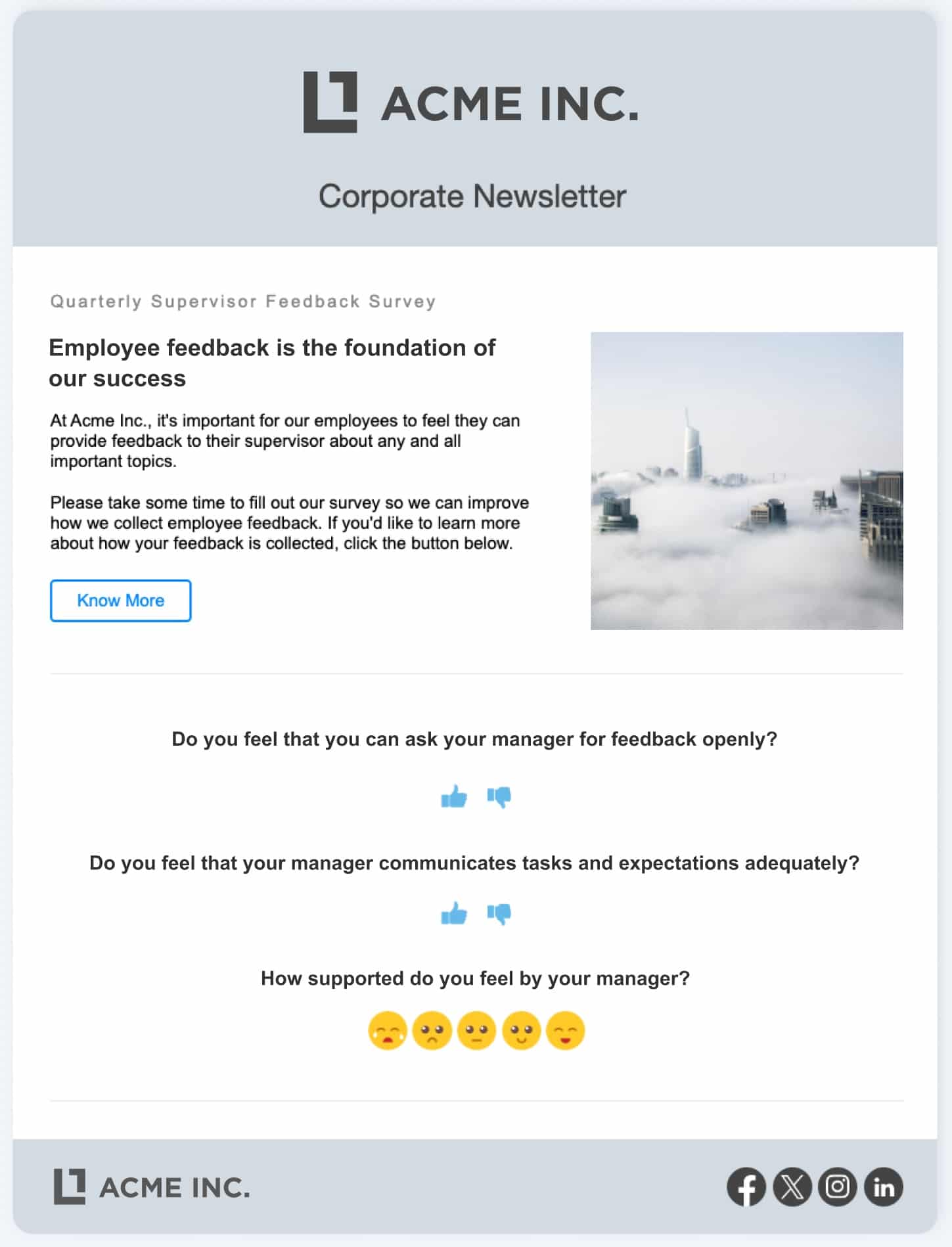
8. Employee onboarding survey email template
Starting new employees on the right path is an important key to their success at your company. An employee onboarding survey email template can help you refine your employee onboarding process and highlight areas where you can improve.
When creating your employee onboarding survey email template, ask questions about different aspects of your onboarding: the materials you provide, the introductions you conduct, the timeframe of your onboarding, and other important parts of the process all make for effective survey content:
Did we provide you all the resources you need to get started at our company? If not, what else could we provide you?
Were you given opportunities during onboarding to ask all the questions you wanted?
Was the timeframe for your onboarding process reasonable?
Start two-way conversations and employee feedback loops
Learn how to engage staff with pulse surveys, content ratings and reactions, custom polls, and more. Ready to send modern emails?
See engagement features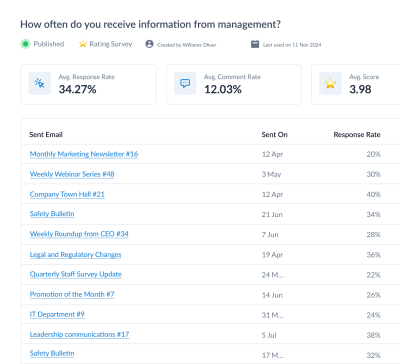

9. Employee exit survey email template
When an employee leaves your company, they can offer informed suggestions about their time at your company and what they feel can be improved. An employee exit survey is a powerful tool to get critical feedback from departing employees about their experience at your company.
Using an employee exit survey email template, you can gather employee feedback on everything from company culture to policies to employee events and everything in between. These are just some of the many questions you can include in your employee exit survey email templates:
I feel comfortable sharing my thoughts and ideas with peers and team leaders. [star rating or emoji reactions]
Are you able to be creative and take risks in your role? If not, why? [thumbs up or down]
I am able to maintain a healthy work-life balance in my current role. [star rating or emoji reactions]
How would you describe the leadership of this organization? [star rating or emoji reactions]
10. Employee training survey email template
Employee training surveys help you understand the efficacy of your training programs and whether employees understand what they’re taught. These surveys can provide important feedback that you can use to refine your training processes. You can also use variations of this kind of survey in the form of post-training survey email templates and pre-training survey email templates.
Effective training programs are crucial for the success and safety of your business. For example, a phishing awareness training program helps your employees from putting sensitive company information at risk. They can also help you gauge employee interest in additional training, like internal communications workshops. Employee training survey email templates help protect both your employees and your business.
I feel that [company] provides adequate training for employees to address every challenge they may face. [star rating or emoji reactions]
Are there any issues you regularly face in your work for which you would like additional support? [thumbs up or down]
Do you feel comfortable asking clarifying questions about training programs to your manager? [thumbs up or down]
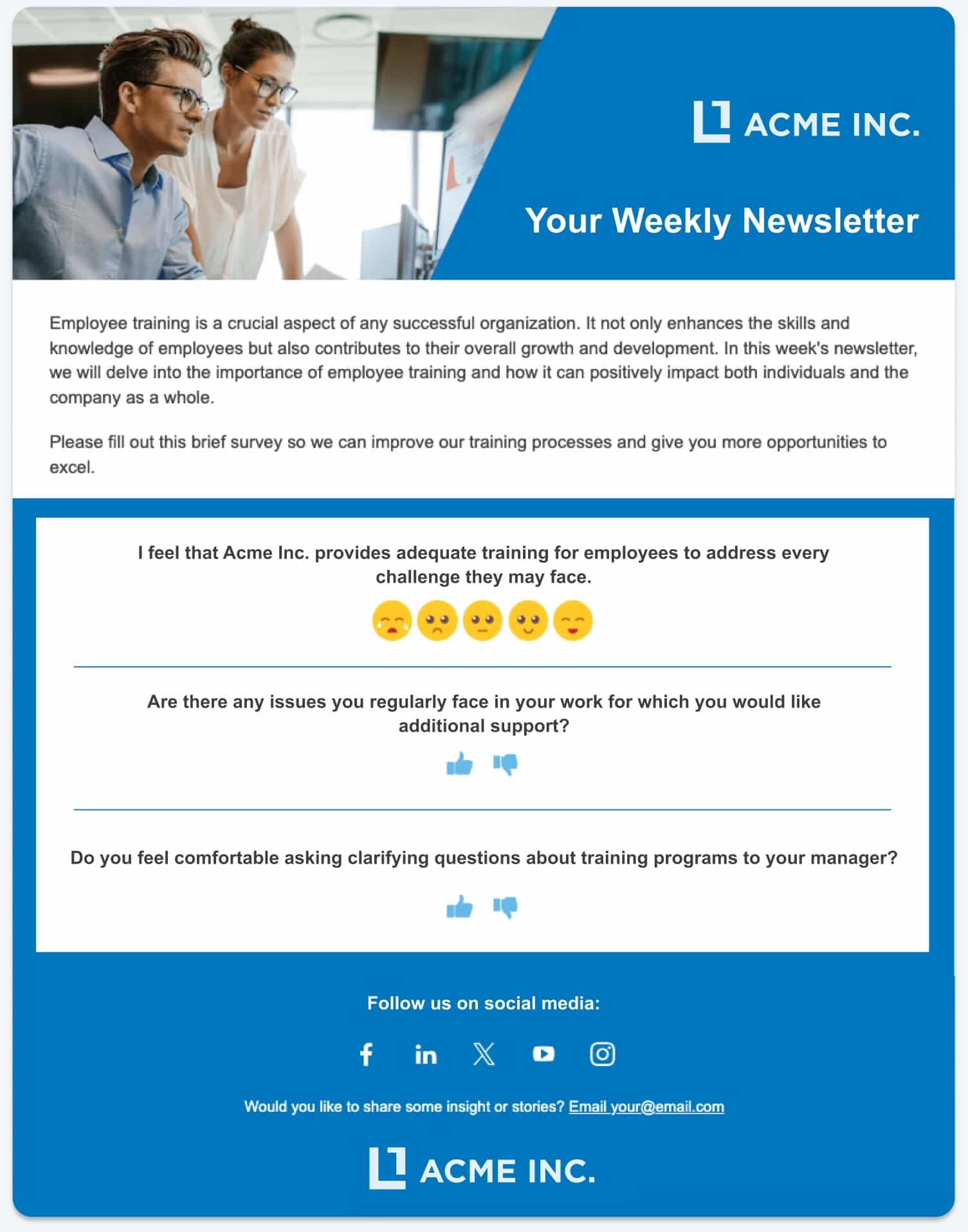
11. Employee performance survey email template
An employee performance survey takes a different approach to evaluating how your employees take to their responsibilities than traditional performance reviews: it asks the employee to rate their own performance. Not only can this help identify levels of engagement, it can also highlight discrepancies between employee and employer performance expectations.
You can inform these questions based on employee engagement statistics you can gather from other surveys and email tracking metrics.
How would you rate your performance in the past year?
Do you feel adequately challenged by your current responsibilities?
I find it easy to focus on producing the best work I can.
12. Employee attitude survey email template
An employee attitude survey email template asks general questions about your company and company culture. Similar to culture survey email templates, the purpose of this survey template is to figure out what affects how employees feel and what you can do to boost the connection between employee and employer.
On your employee attitude survey email template, you should ask questions about factors that can affect the day-to-day experience of your employees, as these will have the biggest impact on their overall attitude toward your company:
I am given regular updates about company activities and policy changes. [star rating or emoji reactions]
My manager regularly communicates with me and offers their guidance when it is needed. [star rating or emoji reactions]
I find my job personally satisfying and challenging. [star rating or emoji reactions]
Build engaging, interactive employee emails in minutes
Build amazing emails quickly and easily using our drag-and-drop template builder. No design or technical expertise needed.
Explore email builder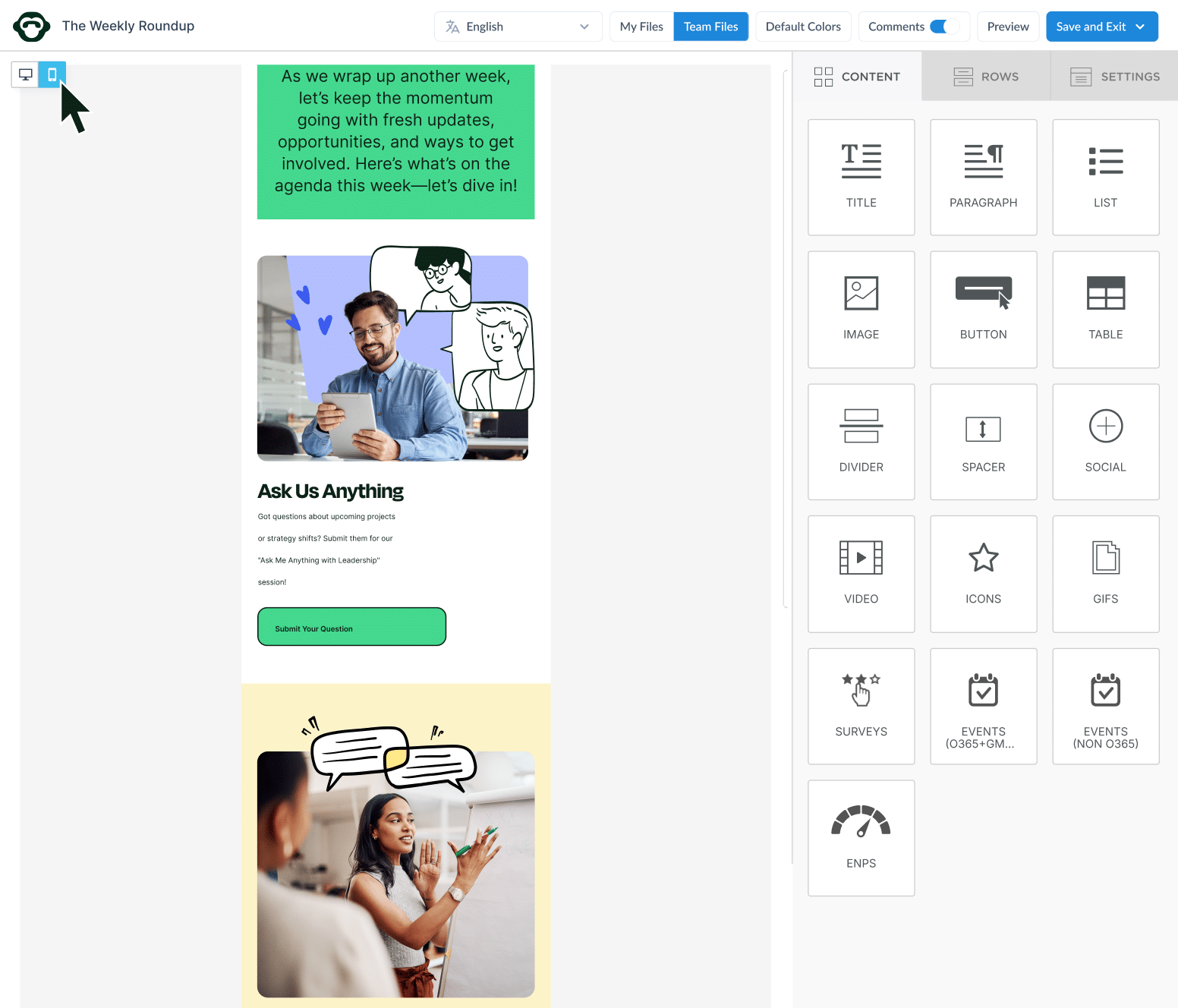
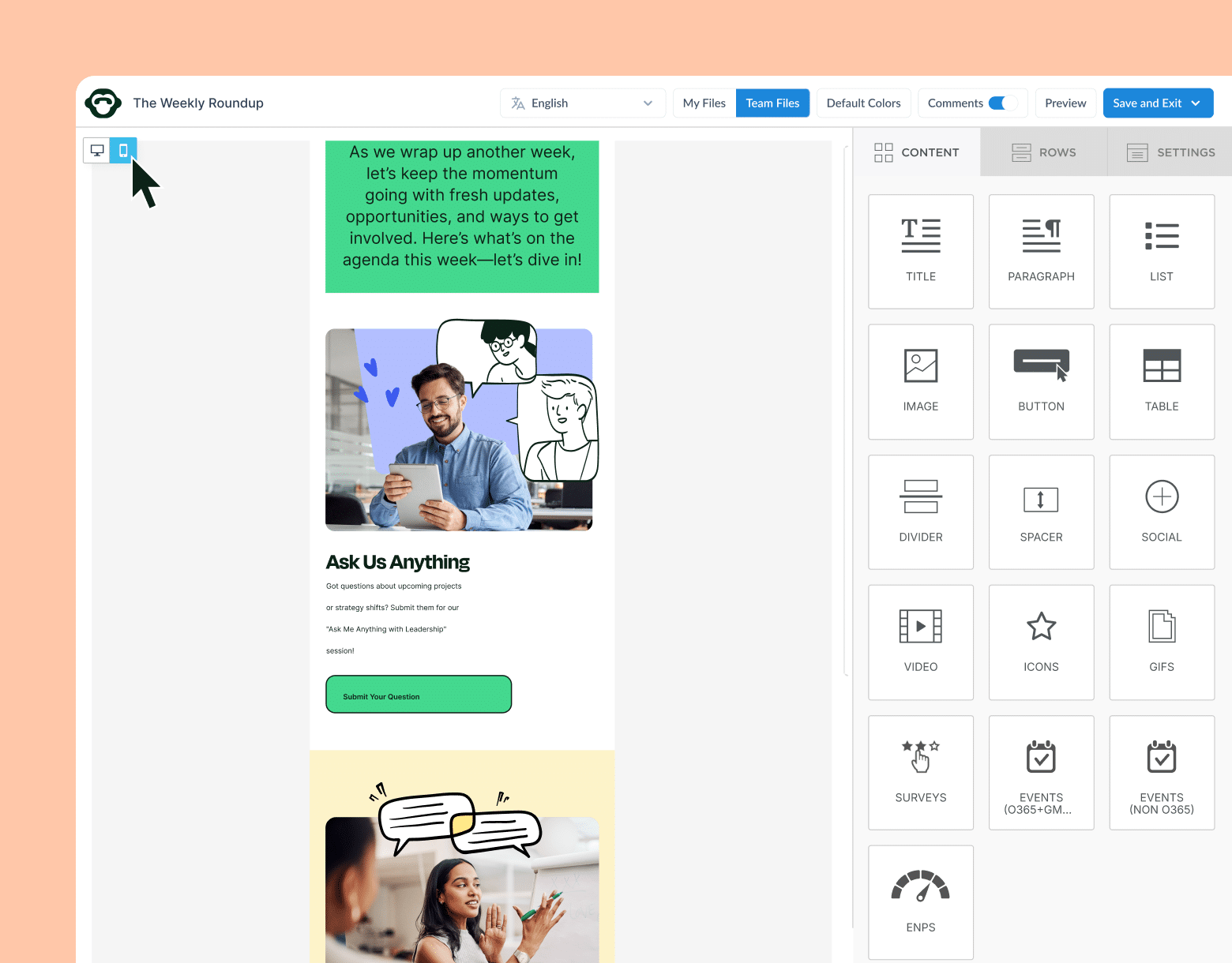
13. Employee happiness survey email template
How happy your employees are at their jobs has a huge impact on their overall engagement. An employee happiness survey helps businesses understand the feelings of their employees and how it relates to their performance.
How happy are you at work? [star rating or emoji reactions]
I receive meaningful recognition for doing good work. [star rating or emoji reactions]
On a scale of 0-10, how likely are you to recommend this organization as a place to work? [eNPS survey]
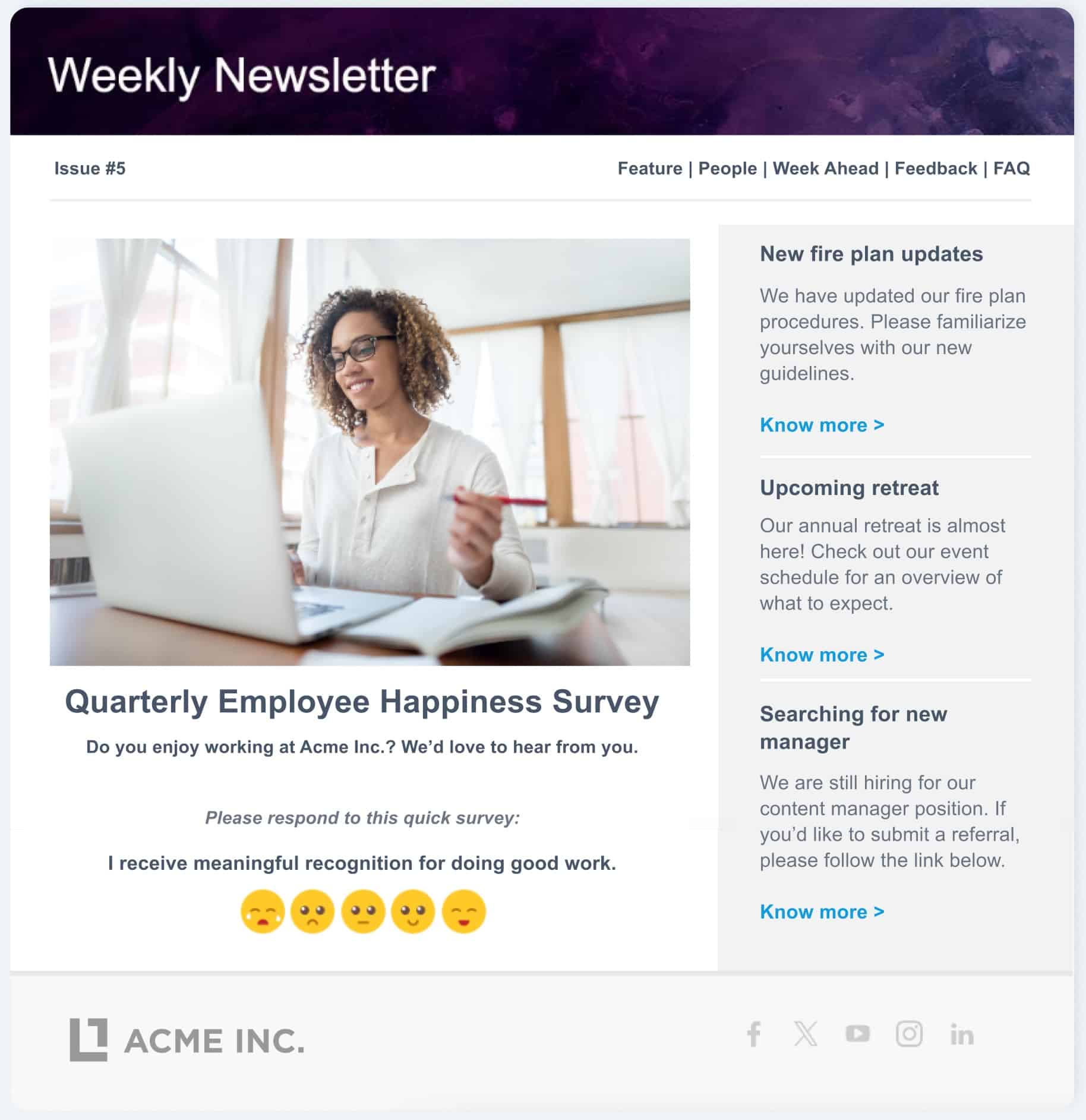
14. Employee recognition survey email template
Providing your employees with the resources they need to succeed is one important aspect of employee engagement; recognizing their success is an equally-important part of this. Employee recognition initiatives play a big role in helping employees feel connected to their workplace and coworkers. It also helps them develop pride in their work and gain fulfillment from doing their best.
Your employee recognition survey can serve at least two important purposes: gauging whether your employees feel adequately recognized by management and peers, and collecting feedback about existing recognition efforts:
Are there employee recognition initiatives that you would like to see [company] implement? [thumbs up or down]
I am happy with the rewards and initiatives I receive when I produce excellent work. [star rating or emoji reactions]
I am recognized when I produce excellent work. [star rating or emoji reactions]
15. Employee of the month survey email template
An important form of employee recognition are employee appreciation days or employee of the month programs. These are initiatives that celebrate the accomplishments of employees with a greater degree of visibility than simple manager-to-employee recognition.
Your employee of the month survey should try to gauge your employees’ feedback similar to your employee recognition survey: understand how they feel about your current employee of the month efforts and gather ideas for improving this initiative:
I enjoy [company]’s Employee of the Month program and appreciate when it recognizes my and my coworkers’ contributions. [star rating or emoji reactions]
[Company]’s Employee of the Month program provides rewards and recognition proportional to the efforts of the employee being recognized. [star rating or emoji reactions]
Do you feel we should update our Employee of the Month efforts? If so, what would you like to see from us? [thumbs up or down]
16. Employee mental health survey email template
Your employees are people, and face challenges in their professional and private lives like anyone else. Your employees’ mental health has a big impact on every aspect of their work. You should critically examine—using the previously-mentioned benefits survey—what mental health resources your company offers employees and what your company can do to facilitate mental health.
Your employee mental health survey collects feedback about what affects your employees mental health and what changes they feel would improve their mental health in the workplace:
I am comfortable raising issues about mental health to my manager. [star rating or emoji reactions]
Does [company] provide adequate mental health resources? If not, what other efforts would you like us to make? [thumbs up or down]
I am happy with the mental health resources and benefits [company] makes available for me. [star rating or emoji reactions]
Do you feel the shift to remote work has affected your overall mental health? If so, please suggest ways that we can improve the transition. [thumbs up or down]
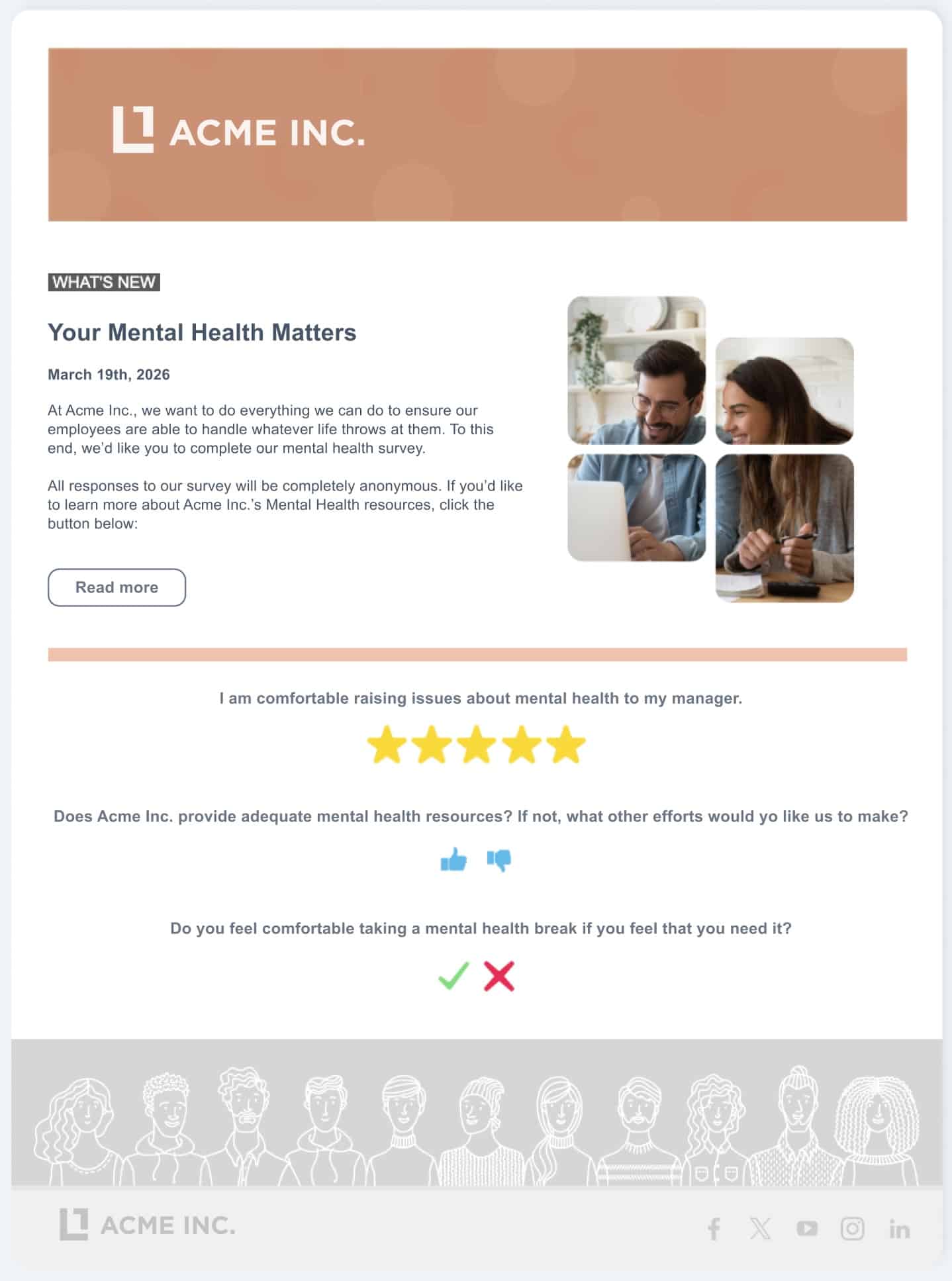
17. Employee satisfaction survey email template
Employee satisfaction is more related to employee happiness than employee engagement—though all the concepts are invariably linked to one another. Measuring employee satisfaction helps businesses understand the personal satisfaction employees get from performing their jobs.
An employee satisfaction survey email template asks questions in order to gain insights into how and why employees feel satisfied with their roles and responsibilities. Like employee happiness surveys, your employee satisfaction survey email templates can utilize eNPS to help you understand levels of employee job satisfaction:
Would you recommend our product or service to your friends and family? [eNPS]
My input is valued by my coworkers and manager. [star rating or emoji reactions]
I solve problems using my unique knowledge and skills on a regular basis. [star rating or emoji reactions]
18. Employee safety perception survey email template
An often overlooked aspect of an employees’ connection to their job is the physical safety they feel at their workplace. Ensuring that your employees feel safe when doing their job is crucial to nurturing both employee engagement and positive mental health.
An employee safety survey can highlight parts of your workplace that may need additional resources to ensure your employees’ safety. These surveys can also help you identify additional training opportunities for your employees:
Overall, I feel safe at my workplace. [star rating or emoji reactions]
I have a good understanding of [company]’s health and safety policies and resources. [star rating or emoji reactions]
There are regular conversations about health and safety between managers and employees. [star rating or emoji reactions]
How dedicated do you feel [company] is toward its employees’ health and safety? [star rating or emoji reactions]
19. Change management email survey template
Whenever your business adopts a new software, procedure, or policy, it’s important to properly communicate what’s changing. Change management communications help businesses make any change as smoothly as possible, but how can you know your employees know everything they need to know?
Change management surveys let your employees share their feedback about any important changes your business has undergone. Not only does this help you understand whether your employees are up-to-date with your changes, but it can also help you develop effective training programs to ensure your employees are ready to succeed:
Do you feel that the new software would increase your team’s productivity? [thumbs up or down]
Are you optimistic about our upcoming change initiative? [thumbs up or down]
What is one thing we could have done better in past change initiatives? [anonymous comments]
What resources would be most helpful in guiding you through our new software? [anonymous comments]
20. Diversity and inclusion email survey template
Embracing your employees’ differences and providing them with resources to make them feel comfortable should be a top priority for every business. Promoting diversity and inclusion in your workplace contributes to an inclusive work environment and stronger company culture.
A diversity and inclusion survey helps you assess how included your employees feel at your business. It can also provide you with ideas and topics for your diversity and inclusion initiatives:
How do you feel our business upholds the principles of DEI? [star rating or emoji reactions]
Do you feel included in decision-making processes relevant to you? [star rating or emoji reactions]
Are tasks and promotions awarded fairly amongst employees? [star rating or emoji reactions]
When problems arise, are they handled in a fair and impartial manner? [star rating or emoji reactions]
21. Employee net promoter score email survey template
Employee net promoter score (eNPS) measures how likely employees are to recommend your product or service to their friends and family.
eNPS survey email templates also measures how likely your employees are to recommend your workplace to family and friends. Using ContactMonkey’s email template builder, you can select eNPS survey email templates and add them to your repertoire of internal survey email templates.
After designing and sending your eNPS survey email templates, the results of your eNPS surveys are displayed in their own section in your email analytics dashboard.
Quick Tip: When writing the survey question for an eNPS survey, be sure to follow the correct formatting guidelines outlined in this blog.
22. Post-event employee survey email template
Company events create opportunities for employees to build solid work relationships with one another. In order to host engaging events that your employees actually want to attend, you can use their feedback to refine your events to make them more appealing to employees.
A post-event employee survey email templates allows you to gather employee feedback about your events after they happen. Use this feedback to improve your future events so they better fit your employees’ expectations. You can also use pre-event survey email templates to gather employee feedback prior to the start of your event.
Here are some common questions you can include in your post-event employee survey email templates:
How relevant was the event to its stated purpose/topic?
How much are you looking forward to our next event?
What is one thing we can do to improve future events?
23. New employee survey email template
While it may seem similar to the employee onboarding survey mentioned before, a new employee survey email template aims to gather more holistic employee feedback about your organization. A new employee is just learning how your business operates, and as such can give you more objective feedback than employees who have internalized those norms and processes.
New employee survey email templates should aim to learn what impressions new employees get when joining your company. This can be about how welcomed they feel by their coworkers, their initial impressions of their manager, or even what they thought about your company or culture before they applied for the position.
These are some example questions you can use on your new employee survey to get an outsider’s opinions on your company:
How would you rate your first impressions of our company culture?
Has a coworker or coworkers gone above and beyond making you feel welcome?
Has your manager made themselves easily accessible for your questions or concerns?
As always, you can enable anonymous comments on your employee surveys when using ContactMonkey’s employee survey tool. This is a great way to let your employees add context to their employee responses and suggest ideas around the question topic.
24. Return-to-work survey email templates
Whether your business is planning a full or partial return to the office, it’s important to understand how your employees feel about it.
A return-to-work survey email template can help you address the concerns your employees may have about coming back to the office so you can craft a plan that ensures your employees are content and confident:
How are you feeling about our return-to-work plan?
Is there anything we can do to ensure our return-to-work plan goes smoothly?
Has your manager communicated with you about how our return-to-work plan will be implement?
25. Hiring manager satisfaction survey email templates
A hiring manager satisfaction survey is related to the onboarding and employee training surveys, but focuses on how your new hires feel about their experience with their hiring managers.
A hiring manager is often the first person that a new hire experiences at their job; how a hiring manager behaves in an interview will influence how employees feel about your company. Try including some of these question on your hiring manager satisfaction survey email template to learn how you can refine your hiring process.
Were you greeted with a smile by your hiring manager at your first interview?
What was your first impression of your hiring manager?
Could your hiring manager have done anything else to make your first experience with [company] even better?
Learn more about the benefits of using email templates for your internal comms.
How to Create and Send an Employee Survey with ContactMonkey?
Using ContactMonkey’s email template builder you can create, customize, and send employee surveys in an instant. We’ll walk you through the basic steps:
Set up your employee survey email template
You can create your employee survey from scratch or choose a premade template from ContactMonkey’s internal communications template library.
Our email template builder’s drag-and-drop controls make it super easy to customize your survey and add your company’s branding. Our survey templates come with employee feedback options built-in, but you can also change up how your employees provide feedback by choosing different survey options.
After you’re happy with the design of your employee survey, you can import your recently-created survey template into your Outlook or Gmail inbox using the ContactMonkey sidebar.
Select which distribution list you want to send your survey to; be sure to send your surveys only to groups of employees who’ll find the questions relevant. Using ContactMonkey’s List Management feature, you can easily create your own custom email lists—without needing IT. Lists created using ContactMonkey can integrate with your Human Resource Information System (HRIS) like Workday and ADP, as well as Azure Active Directory, so they’ll update automatically.
You can add merge tags to personalize the survey’s subject line and body copy based on which employee is receiving it.
Schedule your survey’s send time so it hits your employees’ inboxes when they’ll be most likely to read and respond to it. Use ContactMonkey’s email analytics dashboard to find the times your employees engage with their emails the most based on past sent email campaigns.
If you follow these steps you’ll have a good chance at collecting tons of great feedback on your employee surveys. To analyze your employee survey results, you can easily consult the information which is recorded and visualized within your email analytics dashboard.
Employee Survey Email Template Frequently Asked Questions
Here’s a quick breakdown of what we covered about employee surveys and email templates for employee surveys.
What are employee surveys?
- Employee surveys are internal communications that collect employee feedback about numerous business-related issues.
Why use employee surveys?
- Employee surveys help businesses understand what matters to its employees, measure employee engagement, collect actionable business ideas, and help employees feel heard in their workplace.
What are employee survey email templates?
- Employee survey email templates help internal communicators save time and effort on their employee surveys. They also help keep surveys consistent, even if they’re sent months or years apart.
What questions can I include on employee survey email templates?
- The best employee survey email template questions involve topics that directly affect employees. Give employees a place to voice their concerns and influence decisions by gathering employee feedback about policy changes, engagement initiatives, events, health and safety practices, and much more.
Employee Surveys Help You Achieve Your Business Goals
Whatever you want to learn about your employees, employee surveys are one of the most efficient and reliable ways to gather feedback about whatever topic needs examination. Gain important insights about what issues matter to your employees and get new ideas for how to make your workplace a better place for both employee and employer.
A dedicated employee survey tool like ContactMonkey makes creating, sending, and tracking employee feedback a breeze. Use our survey templates to schedule recurring employee surveys so you can collect comparable results. Not only will these surveys be a great source of ideas and feedback, but you can compare your results over time to gauge whether your employee engagement strategies are having the desired effect.
See how easy it is to create employee survey templates using ContactMonkey by booking a free demo of our internal communications tool for Outlook and Gmail.

